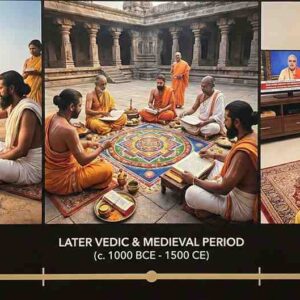A Journey Beyond Beginnings and Endings
Hinduism, one of the world’s oldest spiritual traditions, offers profound insights into the nature of life and death. Rooted in theVedas,Upanishads, andBhagavad Gita, its philosophy transcends the physical realm, viewing existence as a cyclical journey rather than a linear progression. Life and death are seen not as opposites but as interconnected phases of a greater cosmic reality.
This perspective provides a roadmap for understanding existence, helping individuals approach life with purpose and death with equanimity.
1. The Eternal Self: Atman and Brahman
- The Core Belief: Hindu philosophy asserts that every individual possesses an eternal soul, the atman, which is a part of the universal reality, brahman.
- Chandogya Upanishad: “Tat Tvam Asi” (You are That) emphasizes the unity between the self and the cosmos, revealing that life and death are but transitions in the journey of the soul.
- Implication: The body is temporary, but the atman is eternal, transcending birth and death. This belief fosters acceptance of mortality and a focus on spiritual growth.
2. The Cycle of Birth and Rebirth: Samsara
- Samsara Defined: Life and death are part of a cyclical process called samsara, where the soul undergoes a series of births and deaths, shaped by its actions (karma).
- Karma’s Role: The soul’s experiences in each life are determined by its accumulated actions, emphasizing ethical living and accountability.
- Bhagavad Gita: Krishna explains, “Just as a person casts off worn-out garments and puts on new ones, the soul casts off a worn-out body and takes on a new one.”
- Educational Perspective: This belief offers a framework for understanding the consequences of actions, encouraging mindfulness and moral responsibility.
3. Liberation from the Cycle: Moksha
- The Ultimate Goal: The purpose of life, according to Hinduism, is to achieve moksha—liberation from the cycle of birth and rebirth.
- Pathways to Moksha: Hinduism outlines several paths to liberation, including:
- Jnana Yoga: The path of knowledge and self-realization.
- Bhakti Yoga: The path of devotion to the divine.
- Karma Yoga: The path of selfless action.
- Dhyana Yoga: The path of meditation and introspection.
- Pathways to Moksha: Hinduism outlines several paths to liberation, including:
- Philosophical Insight: Liberation is attained when the soul recognizes its oneness with brahman and transcends material attachments.
4. Death as a Transition, Not an End
- The Afterlife in Hinduism: Upon death, the soul embarks on a journey influenced by its karma. It may ascend to higher realms (svarga), descend to lower ones (naraka), or be reborn on Earth.
- Rituals and Their Significance: Hindu death rituals, like cremation and offerings (shraddha), aim to aid the soul’s transition and ensure its peace.
- Cultural Practice: The ashes are often immersed in holy rivers like the Ganga, symbolizing the soul’s return to the divine source.
5. Life’s Purpose Through the Lens of Death
- Embracing Impermanence: Hindu philosophy encourages acceptance of life’s transience, using death as a reminder to lead a meaningful and ethical life.
- Mahabharata: Yudhishthira, when asked about the greatest wonder, replies, “Day after day, countless creatures die, yet those remaining live as if they were immortal.”
- Practical Application: By acknowledging mortality, individuals are inspired to focus on spiritual growth, relationships, and contributions to the world.
6. Parallels with Modern Perspectives
- Mindfulness and Hindu Thought: Contemporary practices like mindfulness and meditation draw heavily from Hindu teachings, helping individuals face life and death with equanimity.
- Scientific Validation: Studies in grief counseling and end-of-life care recognize the value of viewing death as a transition, similar to Hindu beliefs, in fostering acceptance and peace.
7. Reincarnation and Its Philosophical Depth
- A Broader Perspective: The belief in reincarnation expands the view of life beyond a single lifetime, emphasizing growth across multiple existences.
- Bhagavad Gita: “No effort is ever lost in this life or the next,” highlighting that spiritual progress is cumulative.
- Global Influence: Concepts of reincarnation have influenced global spiritual movements, underscoring Hinduism’s universal appeal.
8. Contemporary Relevance of Hindu Views on Life and Death
- Coping with Loss: Hindu teachings provide solace by affirming the eternal nature of the soul and the continuity of existence.
- Guiding Modern Life: By focusing on ethical actions, detachment, and spiritual growth, Hindu philosophy offers a framework for navigating life’s challenges with purpose and grace.
Conclusion: A Philosophy of Eternal Connection
Hinduism’s view of life and death transcends fear and finality, offering a profound understanding of existence as an eternal journey. By emphasizing ethical living, self-realization, and spiritual growth, it inspires individuals to lead purposeful lives while embracing death as a natural transition.
As the teachings of Hindu philosophy continue to resonate with seekers worldwide, they remind us that life and death are not endpoints but milestones on the soul’s path to liberation and unity with the divine. This timeless wisdom guides us to live meaningfully, knowing that every action contributes to an infinite continuum of growth and understanding.












